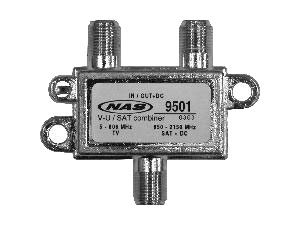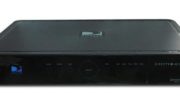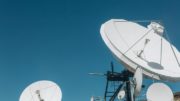This is the question that won’t go away. Dedicated DIYers with a love for antenna TV want to use a single wire to bring the antenna signal into the house with the satellite signal. This is called diplexing, and it was common in the 2000s when DIRECTV hadn’t built out its HD local networks for every market.
While they’ve been discontinued by DIRECTV, Solid Signal sometimes gets a few of the AM21 Antenna Module. This is the only solution that fully integrates off-air channels into the DIRECTV DVR.

However, getting off-air reception to every TV in the house requires that an antenna cable be run to every TV. In the past, it was possible to use a diplexer like the one pictured above. This allowed the satellite signal and the off-air signal to “peacefully coexist” on the same cable. A separator placed at the end of the line split the cable so one end went into the satellite receiver and the other end went into the AM21.
How did this work?
Diplexing is possible because a cable can carry a wide range of frequencies. Some of these frequencies are used for satellite TV, and some are used for over-the-air. It’s like a radio which can receive AM and FM signals from the same antenna; the two don’t overlap so it’s not a problem. As long as you used high-quality RG6 wire for your runs, you didn’t have any problem. DIRECTV’s Genie system and its whole-home sharing (used by older DVRs) work the same way. It uses frequencies that aren’t needed for satellite, and allocates them for use by network information. The two sets of frequencies don’t overlap so it’s not a problem. In fact, DIRECTV’s Genie actually really is a diplexer and combiner in one, putting the network data where it won’t interfere with the satellite signal.

Unfortunately even though a cable can carry a lot of information, it can’t carry everything. Some of the frequencies needed to carry over-the-air television are used by the MoCA adapter. Look at the diagram above. The dark red area is where DIRECTV’s satellite signal sits, while the blue area is where DIRECTV MoCA data, used for Genie and whole-home sharing, sits. As you can see, the yellow area (which shows the OTA frequencies) is also used by MoCA, and if you try to put network data and over-the-air at the same time… it just doesn’t work. So, if you’re used to diplexing, you’ll need to make other arrangements if you use DIRECTV’s Genie DVRs, period. It’s not going to make you feel better to know that very few people still diplex with DIRECTV if you’re one of the people who does it. There’s no getting around the fact that if you want over-the-air antenna, satellite and network, you’re going to need two cables. Either the antenna or network will need its own cable.
Why did DIRECTV do this?
Clearly, DIRECTV could have chosen to put its MoCA signal anywhere it wanted. The reasoning was that since DIRECTV carries so many local channels, most people wouldn’t actually use an antenna anymore. They’re right; the best information available suggests that fewer than 3% of DIRECTV customers also use over-the-air antennas. Of course our dedicated Solid Signal fans are part of that 3% and I wish I had a better answer for you, but it comes down to what works for the largest number of people.
What if I want to go “against your advice” and do it anyway?
There are still some options, although they’re not great. If you have a Genie DVR and Genie clients, diplexing is almost completely off the table. However, if you add a band stop filter between the Genie DVR and the diplexer, it will block the DIRECTV MoCA signal and allow you some ability to diplex. However, this will also break all communication between the Genie DVR and its clients, so proper placement of the band stop filter is critical. It needs to be placed before the first splitter, meaning you’ll need to run two lines from there out to any location where you want to watch antenna TV. Also, expect the performance of your Genie clients to be impacted, with picture quality problems and slow response to button presses. This is because the band stop filter blocks most of the signal but not all of it and some antenna signals are bound to leak through. Some people have reported success by using 2-3 band stop filters chained together but this increases signal loss quite a bit.
What about the diplexers Solid Signal sells?
Those are intended for apartment complexes. They’re used between apartments, and never ever inside the actual apartments or homes, for the reasons I said above.
Bottom line…
Diplexing had its day, and it’s simply off the table now. It’s best to accept that.




